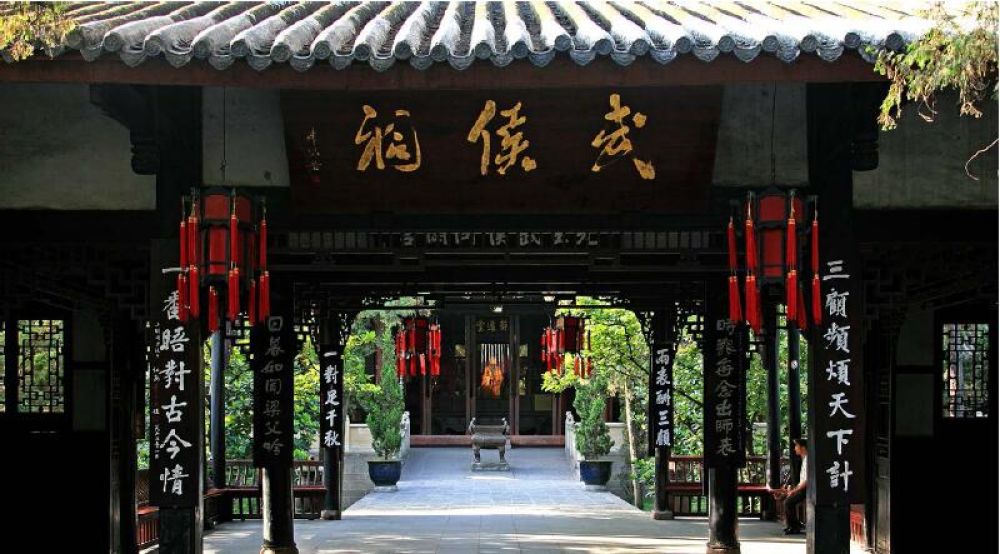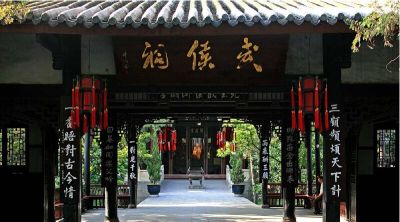

The Memorial Halls of Wuhou Shrine are dedicated to commemorating the legendary figures from the Three Kingdoms period, prominently featuring the Prime Minister of Shu, Zhuge Liang. As visitors wander through these halls, they relive the grandeur of an era marked by loyalty and strategic prowess. The interior reflects ancient Chinese architecture, adorned with statues, inscriptions, and intricate carvings that narrate historical tales. Exquisite murals and artifacts offer a vivid glimpse into the life and accomplishments of Zhuge Liang, alongside that of the heroic Emperor Liu Bei and other notable figures from the period. Each artifact and inscription is a piece of the puzzle that formed the Three Kingdoms' story, and visitors gain a deeper understanding of the influence these historical figures had on China's development. It's more than just a walk through a museum; it's an immersive journey into the past.
Wuhou Shrine's gardens offer a serene escape from the bustling city life of Chengdu. Traditional Chinese gardens are renowned for their symbolic elements, harmoniously blending rockeries, water features, and lush greenery. As visitors meander along the winding paths, they encounter beautifully maintained landscapes that invite contemplation and introspection. These gardens are not just for admiring flora; they are designed to represent the balance of yin and yang, and to mimic the natural world in miniature. Alongside exotic plants, visitors might find traditional pavilions and tea houses, perfect for resting and taking in the tranquil surroundings. The gardens are populated with many statues and steles, which complement the natural beauty with a touch of historical significance, making the stroll both relaxing and informative.
Nestled within the peaceful premises of Wuhou Shrine is the tomb of Liu Bei, the founding emperor of the Shu Kingdom. This cultural relic is a must-visit for history enthusiasts and offers a solemn reminder of a ruler greatly admired for his benevolence and leadership. The tomb itself is a mound of earth, crowned by a stone carving of a horse in repose, symbolizing the resting place of an emperor. Visitors are often seen paying their respects and pondering the vast history that unfolded in this region. The tomb area also includes displays of stone carvings and bilingual information boards that delve into Liu Bei's life and the significance of his final resting place. It's an intimate experience, providing a direct link to the Three Kingdoms period and the opportunity to show reverence for one of China's historic leaders.
The Sanyi Temple, located within the Wuhou Shrine complex, is a temple dedicated to the 'Three Masters' from the Three Kingdoms period: Liu Bei, Guan Yu, and Zhang Fei. It serves as a poignant symbol of the brotherhood and loyalty that these heroes stood for. Architecturally, the temple features traditional Han-style designs, with sweeping tiled roofs and ornate wooden carvings, reflecting the solemnity and grandeur of the historic era. Within the temple, visitors encounter statues of the three sworn brothers, standing proud and solemn, which inspire awe and demand respect. Paying homage to these figures not only honors their memory but also serves as a connection to the profound narratives of loyalty, strategic wisdom, and valor that have shaped Chinese cultural identity and values throughout the centuries. A visit to Sanyi Temple offers an intimate glimpse into the national reverence for these iconic characters.
The Zhaolie Temple is another significant attraction within the Wuhou Shrine that is dedicated to the memory of Liu Bei. This consecrated space houses a sumptuous statue of the emperor, seated in majesty, conveying the respect and esteem in which he was held. A visit here is akin to stepping back in time, with the ambiance capturing the essence of devotion and the commemoration of a revered leader. The temple is tastefully decorated with historical relics, informative plaques, and stunning artworks that detail the achievements and tribulations of Liu Bei's rule. The lighting is somber, and the air carries a weighted silence, allowing visitors the chance to meditate on the past. Going through this temple isn't just about viewing a historical figure; it's about experiencing the cultural reverence and learning about the profound impact the Shu Kingdom had on China's historical narrative.
A cultural gem within the premises of Wuhou Shrine is the Sichuan opera performance. Held in a dedicated theater, the performances blend dramatic storytelling with acrobatics, comedy, and the iconic face-changing art of Bian Lian. These operas are not merely shows; they are an expressive part of the local culture that encapsulates the spirit, traditions, and historical tales of the Sichuan region. Audiences are captivated by the vibrant costumes, the enchanting music, and the sheer skill of the performers who keep ancient storytelling traditions alive. Visitors unfamiliar with the language will still find themselves absorbed by the visceral energy and visual spectacle of the performances. Attending a Sichuan opera inside Wuhou Shrine is not just about entertainment; it's an immersive cultural experience that leaves a lasting impression and a greater appreciation for the intangible heritage of China.
Within the halls of Wuhou Shrine, art enthusiasts will find exhibitions of calligraphy and traditional Chinese painting that showcase the talents of historical and contemporary artists. From delicate brush strokes to bold characters, the calligraphy works are a testament to the skill and patience required to master this form of art. Meanwhile, the paintings offer a visual feast, presenting landscapes, flora, fauna, and scenes of historic significance rendered in the unique aesthetic style of Chinese artistry. These exhibitions are more than displays of art; they are cultural windows into the philosophies, emotions, and historical narratives that have shaped Chinese society. As visitors explore the collections, they can also learn about the symbolism and significance behind each piece, making it an enlightening journey through the visual language of China's artistic heritage.
The tea ceremony is a revered tradition in Chinese culture, and at Wuhou Shrine, visitors have the opportunity to partake in this tranquil and harmonious experience. Set within the picturesque gardens or in one of the shrine's historical buildings, the ceremony is a demonstration of the art of tea-making and the philosophy of tea appreciation. Through this intimate activity, participants learn about the different types of Chinese tea, the proper techniques to brew them, and the customs surrounding their consumption. The tea ceremony is a symbolic event that invites mindfulness and offers a moment of respite, with each sip reflecting the balance and tranquility that the practice aims to achieve. Whether a connoisseur or new to the world of tea, this ceremony provides a peaceful interlude and a taste of an age-old Chinese custom.
The Wuhou Shrine is not only a tribute to historical figures but also a sanctuary for military history buffs, who can delve into displays featuring ancient warfare artifacts. The exhibition showcases an array of weapons, armor, and strategic models that provide insight into the military innovations and tactics of the Three Kingdoms era. From crossbows to broadswords, each artifact tells a story of combat and the quest for power during a turbulent yet formative period of Chinese history. Interactive exhibits and well-documented descriptions add depth to the collection, making it both an educational and eye-opening experience. Observing these relics up close allows visitors to appreciate the craftsmanship and to understand the significance of warfare in shaping the political landscape of ancient China.
For those looking for a hands-on cultural activity, Wuhou Shrine offers workshops on traditional Chinese folk art and crafts. These sessions are led by skilled artisans who share their knowledge of centuries-old techniques in arts such as paper cutting, lantern making, or embroidery. Participants not only learn about the historical and cultural significance of each craft but also get to create their own artistic souvenirs to take home. Engaging in these workshops is an immersive experience that brings ancient Chinese traditions to life and fosters a deeper connection to the cultural essence of the region. It's an ideal family-friendly activity that nurtures creativity, appreciation for artisanal skills, and offers a personal touch to the Wuhou Shrine visit.
